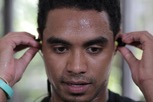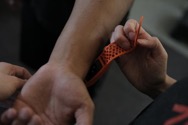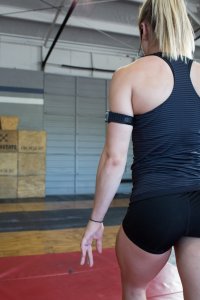Heart Rate Monitor Location Matters
As consumer and medical devices continue to converge, companies are finding more and more applications for PPG sensors in wearable devices from monitoring heart rate and heart rate variability to respiration and blood pressure. Applications ranging from fitness to healthcare and medical devices are finding the accuracy and flexibility of optical heart rate monitors to be ideal for health and medical wearables use cases.
Location Matters
The location of the device, and therefore the heart rate sensor system, on the body can have a huge impact on the accuracy of the device. An accurate PPG sensor can deliver not only heart rate, but many other derivative metrics such as VO2 max, respiration rate, heart rate variability, blood pressure and blood oxygenation.
For those looking to add a PPG sensor to a wearable device, it’s important to understand before you design your product just where on the body you will get the most accurate readings.
Why does location matter? Because accuracy matters. Accurate readings can be make or break for wearable devices because if a consumer or clinician can’t trust the readings from the device, the credibility of the device is diminished very quickly. This can’t lead not just to product returns and lost customers, but potential misdiagnoses or incorrect treatment protocols in the case of medical devices.
While we won’t go into a detailed explanation of PPG-based heart rate monitors, it is important to understand where and why certain parts of the body are more appropriate for heart rate monitor wearables than others. Heart rate monitor accuracy is dependent upon the ability to measure light scattered from flowing blood. Locations that increase unwanted light scattering limit the accuracy, which limits the number of metrics and use cases that you can support for your customers and patients.
Physiology and Technology
Because optical heart rate monitors work by shining light into the body and measuring how light is scattered from blood flow, the technology works best in areas of the body that limit the amount of light that is scattered or absorbed by physiological characteristics that are not related to blood flow. Accuracy may be compromised when trying to gather data from areas of the body that have a diversity of tissues, such as bone, muscle, tendons, etc. It’s also negatively impacted by parts of the body that experience more movement when the body is in motion, such as wrists and ankles.
Locations
Here, in relative order of accurate measurement, are the locations on the body where heart rate monitors on wearables are able to gather the best heart rates:
The Ear
Pros: The ear is stable, with very limited movement even when the body is in motion. Also, because it comprises a relatively high proportion of cartilage and arterioles, there are fewer disturbance factors. The ear boasts an ideal arteriole bank between the anti-tragus and concha of the ear; since this arteriole bank is directly connected to the carotid artery system, blood flow characteristics measured at this location can provide a true picture of what’s going on in the heart. Moreover, this region of the ear does not interfere with the ear canal or audio electronics, and it is more uniform across a larger population than other ear locations, making earbud design more flexible. Add to that the comfort level consumers already have with earbuds, and this location ranks highly.
Cons: Exposure to “environmental noise” – sunlight, in this case – is challenging, especially when shadows are present. No two ears are shaped the same, making it difficult to get a proper universal fit without multiple gel sizes available. And finally, wearing a device in your ear 24×7 is not currently socially acceptable outside of hearing aids.
Mitigation: Three things can be done to temper these concerns.
- Use infrared light to alleviate sunlight issues;
- Use active signal characterization, which works much like noise cancellation, to filter out environmental impactors;
- Use proven designs that enable consistent sensor placement in ears of all shapes and sizes to encourage an accurate read.
The Forehead
 Pros: Very good place to measure heart rate, as there is little relative motion noise and a clean signal can be acquired. It’s also a great spot for integration within helmets, headbands, and other head-worn apparel.
Pros: Very good place to measure heart rate, as there is little relative motion noise and a clean signal can be acquired. It’s also a great spot for integration within helmets, headbands, and other head-worn apparel.
Cons: Wearing a heart rate monitor during daily life activities on your forehead isn’t exactly a fashion statement, and in some cases could be a hindrance, so in certain applications, adoption is questionable or impossible. Also, because it is open to the sun, there may be problems getting enough sunlight rejection in the form factor.
Mitigation: This is where design matters. If outstanding accuracy is your goal, embed the wearable in a headband, a hat or VR/AR headset.
The Wrist
Pros: People are comfortable wearing things on their wrists, and are predisposed to think this is a good location because that’s where they take their pulse.
Cons: The sheer number of bones, tendons, and muscle create higher optical noise in the wrist. Pair with that the high degree of variability in vascular structure, the extreme motion artifacts associated with daily wrist motion, skin tone and blood perfusion across populations, and the wrist becomes one of the most difficult places on the body to measure heart rate accurately.
Mitigation: Active signal characterization identifies and attenuates motion noise. Certain designs can provide enough shadow to mitigate environmental light intrusion, thereby improving signal-to-noise ratio. Using additional wavelengths and other techniques can help overcome the skin tone limitation so that all users can enjoy the same level of accuracy.
The Finger
Pros: The finger generally has very good blood perfusion and a high density of capillary vasculature, which is why your finger tip tends to bleed a lot when cut. This makes the finger, both finger tip and just below the knuckle where rings are typically worn, a great place to measure biometrics with a PPG sensor.
Cons: The biggest issue with finger-based devices tends to be related to blood perfusion. As the body is exposed to colder temperatures, the body prioritizes blood flow to the core to protect vital organs and limits blood flow to the extremities. This lowers blood perfusion in the fingers, making accurate PPG sensor readings more difficult. This can be an issue in older populations too, as blood perfusion at the extremities goes down as we age.
Mitigation: Warm up the hands and fingers before taking a biometric reading. Also, even in the midst of low perfusion, a PPG signal will always exist – thus a viable mitigation is to implement advanced algorithms that are insensitive to low perfusion.
The Arm
Pros: Large amount of blood flow due to the large muscles in the area.
Cons: More relative movement than the head. Depending on the use case and desired user experience, wearing a forearm band may not be comfortable or acceptable for long periods of time.
The Calf
Pros: Like the arm, the calf has high blood flow.
Cons: Activities like running and walking create a shock force that makes accurate readings much harder. Plus, people generally don’t want to wear something strapped to their leg.
The Ankle
Pros: The most positive reason to use the ankle is its inconspicuous location.
Cons: The ankle is filled with tendons and ligaments, and generally has very limited blood flow. The ankle has some of the highest intensity of motion artifacts of any location of the body.
Mitigation for the arm, calf, and ankle: You must rely primarily on testing. Test thoroughly and often, on many people of all shapes, sizes, skin tones and fitness levels doing things that you expect them to do when they use the device. Another mitigation is to incorporate optomechanical decoupling architecture into your band design, which has been shown to help alleviate the impact of motion artifacts during a variety of exercises and body motions.
Implications for Wearables: Design for the objective
As there are pros and cons to optical heart rate monitoring on different parts of the body, the decision about where your new device should rest is highly dependent on the use case and the market for the product.
Military and first responders will have more restrictions on excess gear, yet they’re more likely to be required to wear a helmet or radio earbud which provides greater access to the forehead or ear. Health and medical use cases, on the other hand, have specific human factors and usability considerations, with less regard for fashion and more demand for accuracy and clinical relevance.
The right location for the right task
No matter the design objective or use case for the wearable, data accuracy is critical to the success of any wearable device. If you’ve chosen to utilize a PPG sensor in your next device, it’s important that you keep in mind the different levels of performance accuracy you can expect at different locations on the body.
There are different mitigation strategies for the issues that will be encountered at different body locations. And while application of critical methodologies such as active signal characterization can be a boost, validation and iteration through comprehensive testing are critical to success.